brake sensor MITSUBISHI OUTLANDER PHEV 2017 Owner's Manual (in English)
[x] Cancel search | Manufacturer: MITSUBISHI, Model Year: 2017, Model line: OUTLANDER PHEV, Model: MITSUBISHI OUTLANDER PHEV 2017Pages: 548, PDF Size: 25.5 MB
Page 220 of 548

Economical driving............................................................................. 7-02
Driving, alcohol and drugs
.................................................................. 7-02
Safe driving techniques....................................................................... 7-02
Parking brake...................................................................................... 7-03
Parking................................................................................................ 7-06
Steering wheel height and reach adjustment....................................... 7-07
Inside rear-view mirror....................................................................... 7-07
Outside rear-view mirrors................................................................... 7-09
Power switch....................................................................................... 7-12
Starting and stopping the Plug-in Hybrid EV System........................ 7-14
Selector lever (Joystick type).............................................................. 7-16
Select position indicator...................................................................... 7-18
Electrical Parking switch.................................................................... 7-19
Regenerative braking level selector (paddle)*.................................... 7-19
S-AWC (Super All Wheel Control).................................................... 7-21
4-wheel drive operation...................................................................... 7-23
Inspection and maintenance following rough road operation............. 7-24
Cautions on handling of 4-wheel drive vehicles................................. 7-24
EV switch............................................................................................ 7-25
Battery save mode switch................................................................... 7-27
Battery charge mode switch................................................................ 7-28
Acoustic Vehicle Alerting System (AVAS)....................................... 7-29
Braking................................................................................................ 7-31
Brake auto hold................................................................................... 7-32
Hill start assist..................................................................................... 7-34
Brake assist system............................................................................. 7-36
Emergency stop signal system............................................................ 7-36
Anti-lock brake system (ABS)............................................................ 7-37
Electric power steering system (EPS)................................................. 7-39 Active stability control (ASC)............................................................ 7-40
Cruise control* .................................................................................... 7-42
Speed Limiter*.................................................................................... 7-47
Adaptive Cruise Control System (ACC)*...........................................7-52
Forward Collision Mitigation System (FCM)*...................................7-64
Ultrasonic misacceleration Mitigation System*................................. 7-74
Blind Spot Warning (BSW) (with Lane Change Assist)*.................. 7-80
Rear Cross Traffic Alert (RCTA)*..................................................... 7-83
Lane Departure Warning (LDW)*...................................................... 7-85
Tyre pressure monitoring system (TPMS).......................................... 7-89
Reversing sensor system*................................................................... 7-94
Parking sensors (Front/Rear)*............................................................ 7-98
Rear-view camera*........................................................................... 7-102
Multi Around Monitor*.................................................................... 7-106
Cargo loads....................................................................................... 7-115
Trailer towing....................................................................................7-116 Starting and driving
OGGE17E1 7
Page 258 of 548

Warning display
The ABS and brake force distribution func-tion may not work, so hard braking could
make the vehicle unstable.
Avoid hard braking and high-speed driving.
Stop the vehicle in a safe place immediately
and contact a MITSUBISHI MOTORS Au-
thorized Service Point.
NOTEl The ABS warning lamp and brake warning
lamp illuminate at the same time and the
warning displays appear alternately on the information screen in the multi informationdisplay.After driving on icy roads
E00618800219
After driving on snowy roads, remove any
snow and ice which may have become ad-
hered to the wheel areas.
When doing this, be careful not to damage the wheel speed sensors (A) and cables loca-ted at each wheel on vehicles equipped with an ABS.
Electric power steering
system (EPS) E00629201294
The power steering system operates while thePlug-in Hybrid EV System is operating.
It helps reduce the effort needed to turn the steering wheel.
The power steering system has mechanical
steering capability in case the power assist is lost. If the power assist is lost for some rea-
son, you will still be able to steer your vehi-
cle, but you will notice it takes much more
effort to steer. If this happens, have your ve- hicle inspected at a MITSUBISHI MOTORS
Authorized Service Point.WARNINGl Do not stop the Plug-in Hybrid EV Sys-
tem while the vehicle is moving. Stopping the Plug-in Hybrid EV System would
make the steering wheel extremely hard to turn, possibly resulting in an accident.NOTEl During repeated full-lock turning of the
steering wheel (for example, while you are manoeuvring the vehicle into a parking space), a protection function may be activa-
ted to prevent overheating of the power steering system. This function will make the
steering wheel gradually harder to turn. In
this event, limit your turning of the steering wheel for a while. When the system has
cooled down, the steering action will return to normal.
Electric power steering system (EPS)
7-39OGGE17E1Starting and driving7 FrontRear
Page 271 of 548
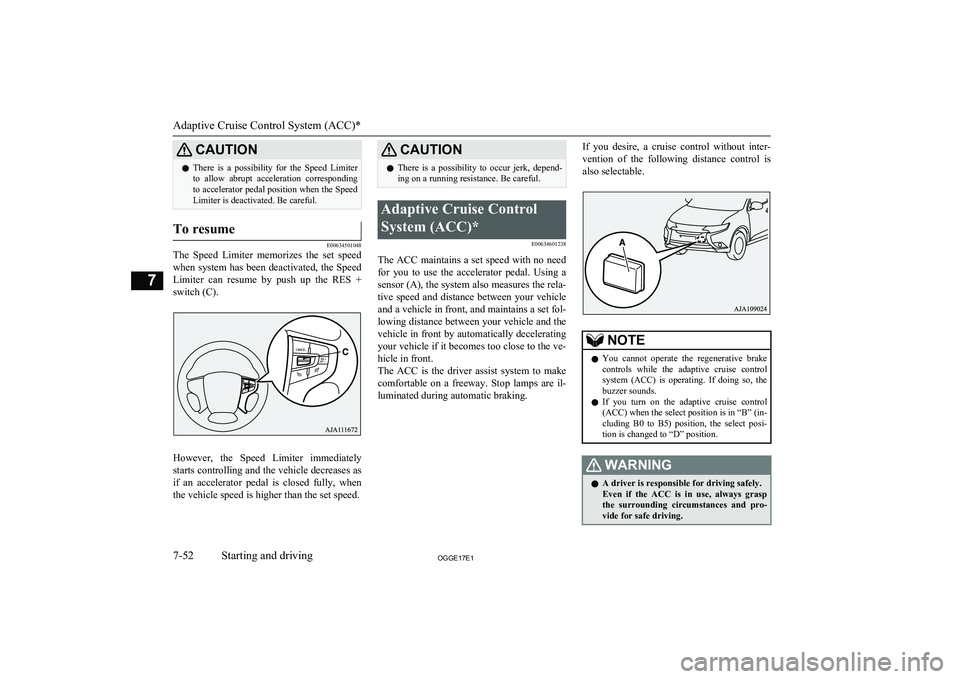
CAUTIONlThere is a possibility for the Speed Limiter
to allow abrupt acceleration corresponding
to accelerator pedal position when the Speed Limiter is deactivated. Be careful.To resume
E00634501048
The Speed Limiter memorizes the set speed
when system has been deactivated, the Speed
Limiter can resume by push up the RES +
switch (C).
However, the Speed Limiter immediately
starts controlling and the vehicle decreases as if an accelerator pedal is closed fully, whenthe vehicle speed is higher than the set speed.
CAUTIONl There is a possibility to occur jerk, depend-
ing on a running resistance. Be careful.Adaptive Cruise Control
System (ACC)* E00634601238
The ACC maintains a set speed with no needfor you to use the accelerator pedal. Using a
sensor (A), the system also measures the rela- tive speed and distance between your vehicle
and a vehicle in front, and maintains a set fol- lowing distance between your vehicle and thevehicle in front by automatically decelerating
your vehicle if it becomes too close to the ve-
hicle in front.
The ACC is the driver assist system to make comfortable on a freeway. Stop lamps are il-luminated during automatic braking.
If you desire, a cruise control without inter-
vention of the following distance control is
also selectable.NOTEl You cannot operate the regenerative brake
controls while the adaptive cruise control
system (ACC) is operating. If doing so, the
buzzer sounds.
l If you turn on the adaptive cruise control
(ACC) when the select position is in “B” (in-
cluding B0 to B5) position, the select posi-
tion is changed to “D” position.WARNINGl A driver is responsible for driving safely.
Even if the ACC is in use, always grasp the surrounding circumstances and pro- vide for safe driving.
Adaptive Cruise Control System (ACC)*
7-52OGGE17E1Starting and driving7
Page 272 of 548
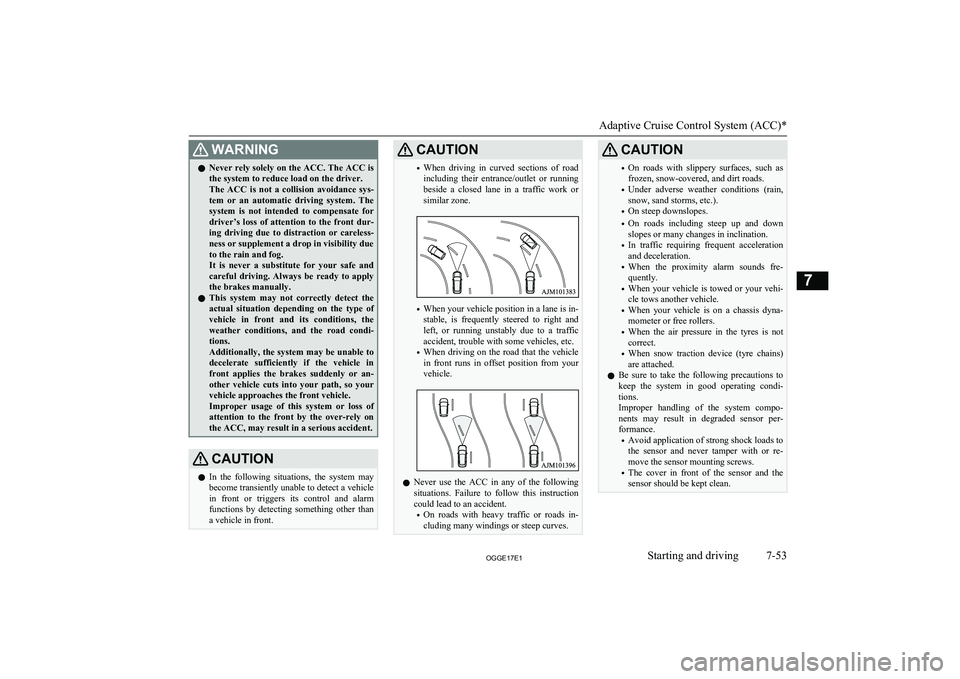
WARNINGlNever rely solely on the ACC. The ACC is
the system to reduce load on the driver.
The ACC is not a collision avoidance sys-
tem or an automatic driving system. The system is not intended to compensate for
driver’s loss of attention to the front dur-
ing driving due to distraction or careless-
ness or supplement a drop in visibility due
to the rain and fog.
It is never a substitute for your safe and careful driving. Always be ready to applythe brakes manually.
l This system may not correctly detect the
actual situation depending on the type of vehicle in front and its conditions, theweather conditions, and the road condi-
tions.
Additionally, the system may be unable to
decelerate sufficiently if the vehicle in front applies the brakes suddenly or an- other vehicle cuts into your path, so yourvehicle approaches the front vehicle.Improper usage of this system or loss of
attention to the front by the over-rely on the ACC, may result in a serious accident.CAUTIONl In the following situations, the system may
become transiently unable to detect a vehicle in front or triggers its control and alarm
functions by detecting something other than a vehicle in front.CAUTION• When driving in curved sections of road
including their entrance/outlet or running beside a closed lane in a traffic work or
similar zone.
• When your vehicle position in a lane is in-
stable, is frequently steered to right and left, or running unstably due to a trafficaccident, trouble with some vehicles, etc.
• When driving on the road that the vehicle
in front runs in offset position from your
vehicle.
l Never use the ACC in any of the following
situations. Failure to follow this instructioncould lead to an accident.
• On roads with heavy traffic or roads in-
cluding many windings or steep curves.
CAUTION• On roads with slippery surfaces, such as
frozen, snow-covered, and dirt roads.
• Under adverse weather conditions (rain,
snow, sand storms, etc.).
• On steep downslopes.
• On roads including steep up and down
slopes or many changes in inclination.
• In traffic requiring frequent acceleration
and deceleration.
• When the proximity alarm sounds fre-
quently.
• When your vehicle is towed or your vehi-
cle tows another vehicle.
• When your vehicle is on a chassis dyna-
mometer or free rollers.
• When the air pressure in the tyres is not
correct.
• When snow traction device (tyre chains)
are attached.
l Be sure to take the following precautions to
keep the system in good operating condi-
tions.
Improper handling of the system compo-
nents may result in degraded sensor per- formance.
• Avoid application of strong shock loads to
the sensor and never tamper with or re- move the sensor mounting screws.
• The cover in front of the sensor and the
sensor should be kept clean.
Adaptive Cruise Control System (ACC)*
7-53OGGE17E1Starting and driving7
Page 273 of 548

CAUTION•Do not cover the sensor mounted area
(shaded area as shown in the illustration)
with a sticker, licence plate or anything
such as a grill guard, etc.
• The sensor front cover should not be
modified or painted.
• Avoid using different size tyres from
those specified and maintain even tyre
wear.
• Do not modify the suspension of your ve-
hicle.
CAUTIONl When the cover in front of the sensor or the
sensor is deformed by an accident, please do
not use the ACC and contact a
MITSUBISHI MOTORS Authorized Serv-
ice Point.
When ACC detects no vehicle
in front within the set distance
Your vehicle runs at a speed to which you set. It is possible to set the speed between ap-
proximately 40 and 180 km/h.
NOTEl If the vehicle speed exceed the set speed on
down slope, the system automatically ap-plies the brake to maintain the vehicle speed.
l When depressing the brake pedal while auto-
matic brake is applied, the brake pedal is felt solidly, but it is not abnormal. You can moredepress the pedal and it provides greater
braking force.
l Sound is heard while automatic brake, but it
is operated a brake control and not abnor-
mal.When ACC detects a vehicle in
front within the set distance
The ACC makes control to maintain a fol- lowing distance (time gap) matched with the vehicle speed between your vehicle and a ve-
hicle in front while also activating brakes as necessary.
If the vehicle in front stops, the ACC reacts
to it by stopping your vehicle.
Depress the brake pedal as soon as your vehi- cle comes to a stop.
Adaptive Cruise Control System (ACC)*
7-54OGGE17E1Starting and driving7
Page 278 of 548
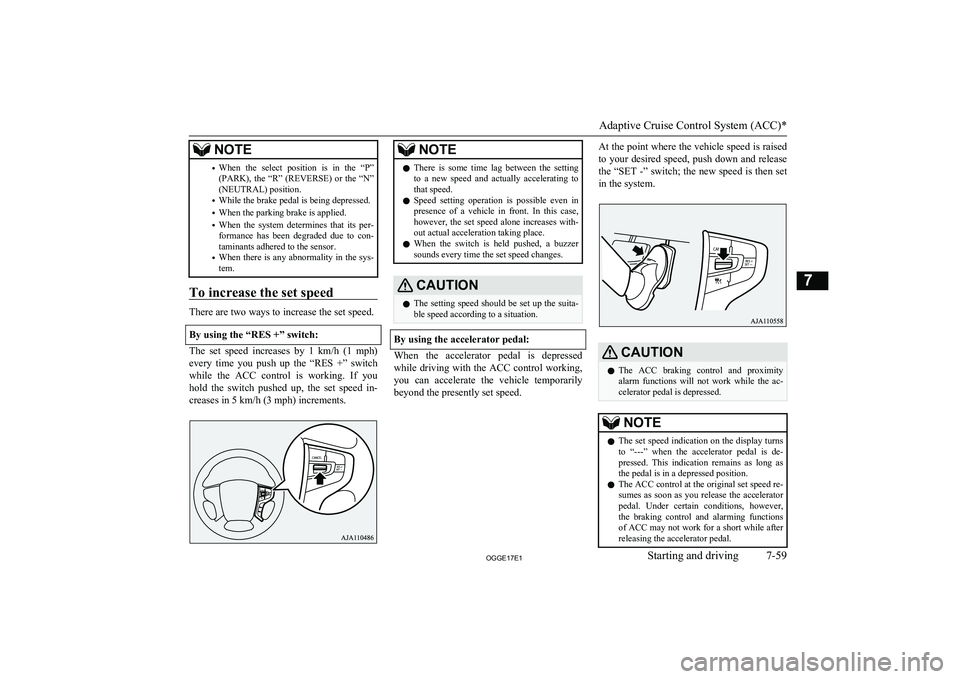
NOTE•When the select position is in the “P”
(PARK), the “R” (REVERSE) or the “N”
(NEUTRAL) position.
• While the brake pedal is being depressed.
• When the parking brake is applied.
• When the system determines that its per-
formance has been degraded due to con-
taminants adhered to the sensor.
• When there is any abnormality in the sys-
tem.
To increase the set speed
There are two ways to increase the set speed.
By using the “RES +” switch:
The set speed increases by 1 km/h (1 mph) every time you push up the “RES +” switch
while the ACC control is working. If you hold the switch pushed up, the set speed in-creases in 5 km/h (3 mph) increments.
NOTEl There is some time lag between the setting
to a new speed and actually accelerating tothat speed.
l Speed setting operation is possible even in
presence of a vehicle in front. In this case, however, the set speed alone increases with-
out actual acceleration taking place.
l When the switch is held pushed, a buzzer
sounds every time the set speed changes.CAUTIONl The setting speed should be set up the suita-
ble speed according to a situation.
By using the accelerator pedal:
When the accelerator pedal is depressed
while driving with the ACC control working,you can accelerate the vehicle temporarily
beyond the presently set speed.
At the point where the vehicle speed is raised
to your desired speed, push down and release
the “SET -” switch; the new speed is then set in the system.CAUTIONl The ACC braking control and proximity
alarm functions will not work while the ac- celerator pedal is depressed.NOTEl The set speed indication on the display turns
to “---” when the accelerator pedal is de- pressed. This indication remains as long as
the pedal is in a depressed position.
l The ACC control at the original set speed re-
sumes as soon as you release the accelerator
pedal. Under certain conditions, however,
the braking control and alarming functions of ACC may not work for a short while afterreleasing the accelerator pedal.
Adaptive Cruise Control System (ACC)*
7-59OGGE17E1Starting and driving7
Page 281 of 548
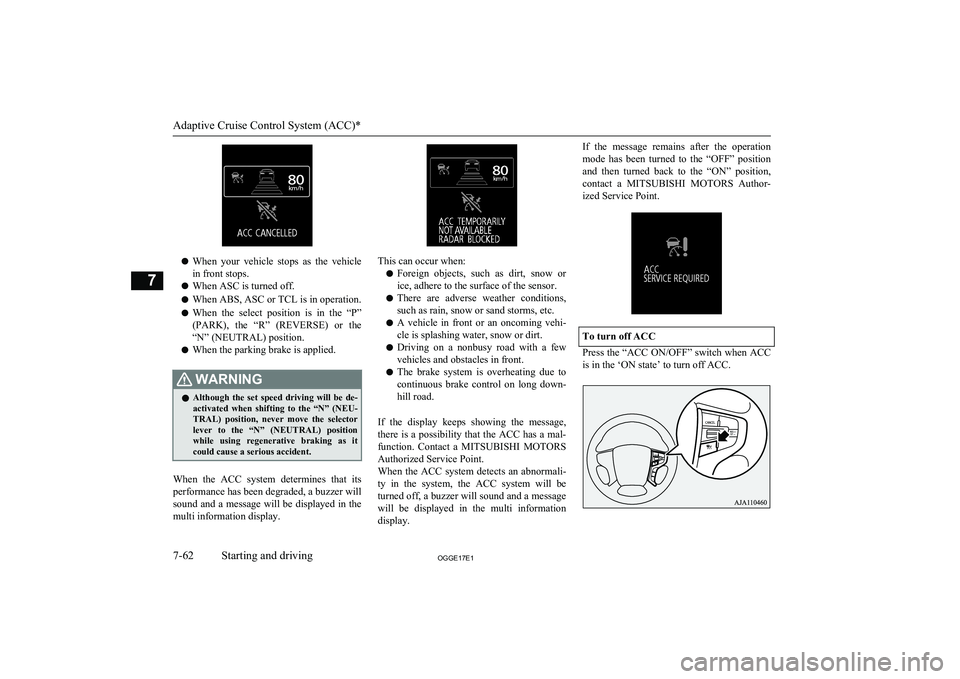
lWhen your vehicle stops as the vehicle
in front stops.
l When ASC is turned off.
l When ABS, ASC or TCL is in operation.
l When the select position is in the “P”
(PARK), the “R” (REVERSE) or the “N” (NEUTRAL) position.
l When the parking brake is applied.
WARNINGlAlthough the set speed driving will be de-
activated when shifting to the “N” (NEU- TRAL) position, never move the selector lever to the “N” (NEUTRAL) position
while using regenerative braking as it
could cause a serious accident.
When the ACC system determines that its
performance has been degraded, a buzzer will sound and a message will be displayed in the multi information display.
This can occur when:
l Foreign objects, such as dirt, snow or
ice, adhere to the surface of the sensor.
l There are adverse weather conditions,
such as rain, snow or sand storms, etc.
l A vehicle in front or an oncoming vehi-
cle is splashing water, snow or dirt.
l Driving on a nonbusy road with a few
vehicles and obstacles in front.
l The brake system is overheating due to
continuous brake control on long down- hill road.
If the display keeps showing the message,
there is a possibility that the ACC has a mal-
function. Contact a MITSUBISHI MOTORS
Authorized Service Point.
When the ACC system detects an abnormali-
ty in the system, the ACC system will be turned off, a buzzer will sound and a message
will be displayed in the multi information display.
If the message remains after the operation
mode has been turned to the “OFF” position
and then turned back to the “ON” position, contact a MITSUBISHI MOTORS Author-
ized Service Point.
To turn off ACC
Press the “ACC ON/OFF” switch when ACC is in the ‘ON state’ to turn off ACC.
Adaptive Cruise Control System (ACC)*
7-62OGGE17E1Starting and driving7
Page 283 of 548
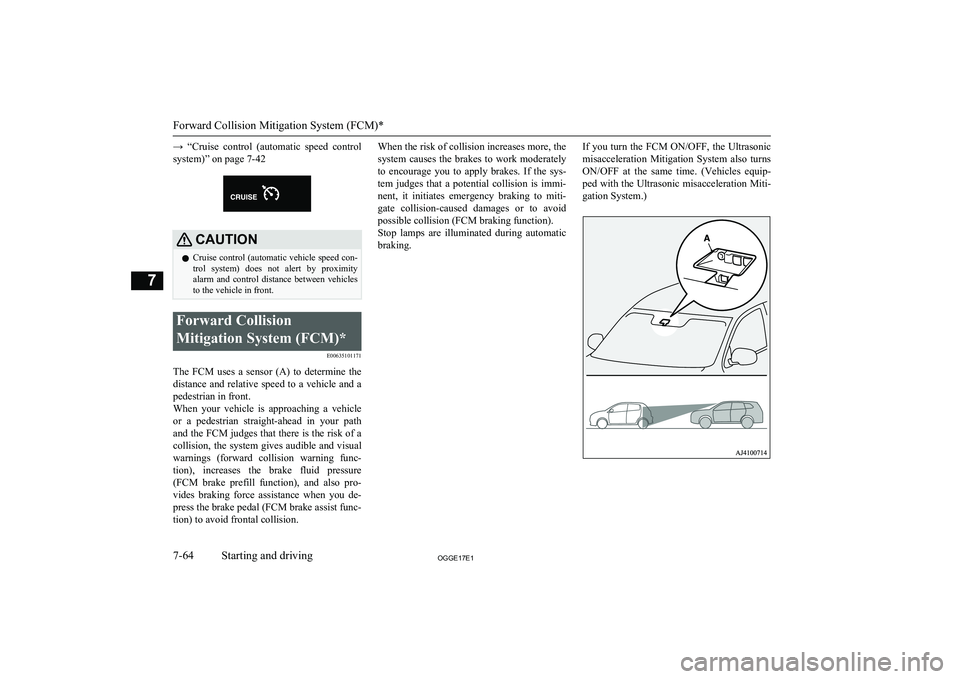
→ “Cruise control (automatic speed controlsystem)” on page 7-42CAUTIONl Cruise control (automatic vehicle speed con-
trol system) does not alert by proximity
alarm and control distance between vehicles to the vehicle in front.Forward Collision
Mitigation System (FCM)* E00635101171
The FCM uses a sensor (A) to determine thedistance and relative speed to a vehicle and apedestrian in front.
When your vehicle is approaching a vehicle
or a pedestrian straight-ahead in your path
and the FCM judges that there is the risk of a collision, the system gives audible and visualwarnings (forward collision warning func-
tion), increases the brake fluid pressure (FCM brake prefill function), and also pro-vides braking force assistance when you de-press the brake pedal (FCM brake assist func-
tion) to avoid frontal collision.
When the risk of collision increases more, the
system causes the brakes to work moderately
to encourage you to apply brakes. If the sys- tem judges that a potential collision is immi- nent, it initiates emergency braking to miti-gate collision-caused damages or to avoid
possible collision (FCM braking function).
Stop lamps are illuminated during automatic braking.If you turn the FCM ON/OFF, the Ultrasonic
misacceleration Mitigation System also turns ON/OFF at the same time. (Vehicles equip-ped with the Ultrasonic misacceleration Miti-
gation System.)
Forward Collision Mitigation System (FCM)*
7-64OGGE17E1Starting and driving7
Page 289 of 548

As you make selection, the selected alarmtiming is displayed on the information screen
of the multi-information display. Even after turning off the FCM or setting the operation
mode to “OFF”, the system retains your last selected alarm timing in memory.
When “FAR” is selected
When “MIDDLE” is selected
When “NEAR” is selected
CAUTIONl For the FCM brake prefill, the FCM brake
assist and the FCM braking functions, the function triggering timing cannot be changed.When a problem is detected
E00652100023
When the FCM system determines that its
performance has been degraded, the FCM
will become inoperative.
This can occur when:
l Foreign objects, such as dirt, snow or
ice, adhere to the windscreen of the sen-
sor portion.
l There are adverse weather conditions,
such as rain, snow, sand storms, etc.
l A vehicle in front or an oncoming vehi-
cle is splashing water, snow or dirt.
The “DRIVER ASSISTANCE CAMERA BLOCKED” message will appear and the
indicator will appear on the information
screen of the multi-information display.
When the sensor performance returns, the
FCM functions will resume operation.
If the display keeps showing the message,
there is a possibility that the sensor has a malfunction. Contact a MITSUBISHI
MOTORS Authorized Service Point for in-
spection of the sensor.
NOTEl The “DRIVER ASSISTANCE CAMERA
BLOCKED” message may temporarily ap-
pear on the information screen when the sen-
sor cannot detect a vehicle, a pedestrian or an object within range. This is not a mal-
function. When a vehicle or an object comes within range, the FCM function will resume
and the message will go off.
l The “DRIVER ASSISTANCE CAMERA
BLOCKED” message may appear on the in- formation screen when driving on a non-busy road with a few vehicles and obstacles
in front.
If the system becomes temporarily unavaila-
ble for some reason, the following message
may appear.
Forward Collision Mitigation System (FCM)*
7-70OGGE17E1Starting and driving7
Page 295 of 548

CAUTIONlThe Ultrasonic misacceleration Mitigation System does not operate in the following conditions:
• The operation mode is other than ON.
• The Ultrasonic misacceleration Mitigation System is set to OFF by operating the Forward collision mitigation system (FCM) and Ultrasonic misaccelera-
tion Mitigation System ON/OFF switch.
• The select position is in the “P” or “N” position.
• The ASC is set to OFF by operating the “ASC OFF switch” on page 7-41.
l It sometimes happens that a motorcycle, bicycle or pedestrian are detected as obstacles, but these are not the object of the Ultrasonic misacceleration Mitiga-
tion System operation.
l The Ultrasonic misacceleration Mitigation System may not operate in the following conditions.
• The sensors or surroundings have been wiped by hand.
• The stickers or accessories have been attached to the sensors or surroundings.
• When driving in the place which the outside temperature changes suddenly (tunnel or garage etc.).
• Under adverse weather conditions (rain, strong winds, snow, sand storms, etc.).
• When approaching an obstacle too closely.
• When a vehicle cuts in front or behind your vehicle very closely.
• When your vehicle changed the course and approached immediately behind an obstacle.
• When only a part of the obstacle is within the detection areas of the sensor.
• When the rain, snow, water or dirt adheres to the sensor.
• When the sensor is extremely hot or cold (while the vehicle is parked for a long period of time under a blazing sun or in cold weather).
• Immediately after Plug-in Hybrid EV System starting.
• When driving on a road with many and successive curves, including when passing their entrances and outlets.
• When you are driving on a road with steep and alternating up and down slopes.
• When a road surface is surging, and there is unevenness.
• When the system judges driver’s steering or gear shifting actions as evasive actions to avoid collision.
• For a short period after the system judges the repeated depression of the accelerator pedal at a few seconds interval as a release operation.
• When the vehicle body is extremely inclined by carrying heavy loads or improper adjustment of the tyre pressure.
• When the driving is unstable due to an accident or trouble.
• The system receives ultrasonic noise from other sources (the horns of other vehicles, motorcycle engines, brakes, radios, pouring rain, splashing water,
snow traction device (tyre chains), etc.).
• Obstacle is not vertical to the ground, the obstacle is not at right angles to vehicle traveling direction, or when there is uneven walls and wavy walls.
Ultrasonic misacceleration Mitigation System*
7-76OGGE17E1Starting and driving7